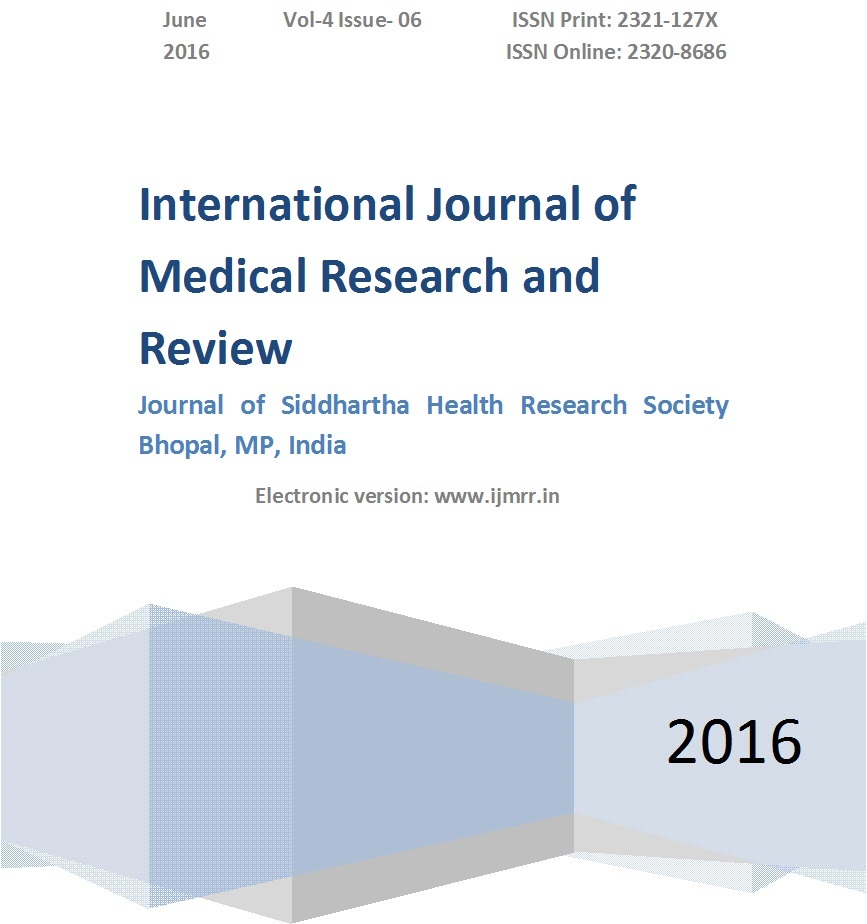Correlation of Expression of ER, PR with the onset age, histopathological grading, size of tumor and metastatic behavior of invasive duct cell carcinoma breast
Abstract
Carcinoma breast is a heterogeneous malignancy with distinct age of onset pattern. Age specific incidence profile of breast carcinoma shows exponential rise until menopause and then slow after menopause. Largely early onset breast carcinoma represents inherited cause and late onset breast cancer following extended exposure to cancer promoters. Expression of ER shows gradual increase beginning in 3rd decade to a plateau by 6th decade. The present study is aimed at the correlation of expression of ER, PR with the onset of age of breast cancer, histopathological grading, size of tor and metastatic behavior.
Material and Method: The study was carried out in 80 cases of invasive duct cell carcinoma. Clinicopathological findings, histopathological grading and immunohistochemistry for ER and PR expression were performed.
Result and Conclusion: Majority cases (85%) of invasive duct cell carcinoma fall in 31 to 60 years of age group. Most of the patients show more than 2 cms size (90%). Majority of the patients fall in histopathological grade II (67.5%) followed by grade I (27.5%). Lymph node metastasis was seen in 45% cases in all grades. ER and PR expression show declining trend with age of onset of breast carcinoma. It reflects dysregulated ER and PR expression which contribute to the breast carcinoma etiology. Loss of ER expression result in to distinct age of onset pattern, therefore early onset breast cancer may be benefitted by hormone therapy. Metastatic behavior is independent of ER and PR expression.
Downloads
References
2. Anderson WF, Pfeiffer RM, Dores GM, Sherman ME. Comparison of age distribution patterns for different histopathologic types of breast carcinoma. Cancer Epidemiol Biomarkers Prev. 2006 Oct;15(10):1899-905.
3. Quong J, Eppenberger-Castori S, Moore D 3rd, Scott GK, Birrer MJ, Kueng W, Eppenberger U, Benz CC. Age-dependent changes in breast cancer hormone receptors and oxidant stress markers. Breast Cancer Res Treat. 2002 Dec;76(3):221-36.
4. Biswal, P., et al. Correlation of Hormonal Receptors Estrogen Receptor, Progesterone Receptor and Her-2/Neu with Tumor Characteristics in Breast Carcinoma: Study of 100 Consecutive Cases. International Journal of Clinical Medicine. 2015,6, 961-966. doi: 10.4236/ijcm.2015.612126.
5. Azizun-Nisa, Bhurgri Y, Raza F, Kayani N. Comparison of ER, PR and HER-2/neu (C-erb B 2) reactivity pattern with histologic grade, tumor size and lymph node status in breast cancer. Asian Pac J Cancer Prev. 2008 Oct-Dec;9(4):553-6.
6. Ambroise M, Ghosh M, Mallikarjuna VS, Kurian A. Immunohistochemical profile of breast cancer patients at a tertiary care hospital in South India. Asian Pac J Cancer Prev. 2011;12(3):625-9.
7. Rashed M M et al. The association of Her-2/neu overexpression in relation to p53 nuclear accumulation, hormone receptor status and common clinicopathological prognostic parameters in a series of Egyptian women with invasive ductal carcinoma. Eur J Gen Med.2007 4(2), 73-79.
8. Rao M, Khan AJ, Moran MS, Hirshfield KM, Ganesan S, Haffty BG, Goyal S. Clinicopathologic presentation of Asian-Indian American (AIA) women with stage 0, I & II breast cancer. J Immigr Minor Health. 2011 Feb;13(1):42-8. doi: 10.1007/s10903-010-9359-z.
9. Saadatmand S, Bretveld R, Siesling S, Tilanus-Linthorst MM. Influence of tumour stage at breast cancer detection on survival in modern times: population based study in 173,797 patients. BMJ. 2015 Oct 6;351:h4901. doi: 10.1136/bmj.h4901.
10. Benz CC. Impact of aging on the biology of breast cancer. Crit Rev Oncol Hematol. 2008 Apr;66(1):65-74. Epub 2007 Oct 18. doi.org/10.1016/j.critrevonc.2007.09.001
11. Post WS, Goldschmidt-Clermont PJ, Wilhide CC, Heldman AW, Sussman MS, Ouyang P, Milliken EE, Issa JP. Methylation of the estrogen receptor gene is associated with aging and atherosclerosis in the cardiovascular system. Cardiovasc Res. 1999 Sep;43(4):985-91.
12. Rena G, Lapidus, Anne T Ferguson, et al. Methylation of estrogen and progesterone receptor gene 5’CpG island correlates with lack of estrogen and progesterone receptor gene expression in breast tumors. Clin Cancer Res. 1996 May;2(5): 805 – 810.
13. Seema A Khan, Mary A M Rogers, Kamal K Khurana, Michael M, Meguid, Patricia J, Numann. Estrogen Receptor expression in benign breast epithelium and breast cancer risk. J of National Cancer Institute. 1998; 90 (1): 37-42. doi: 10.1093/jnci/90.1.37
14. Munjal K, Ambaye A, Evans MF, Mitchell J, Nandedkar S, Cooper K. Immunohistochemical analysis of ER, PR, Her2 and CK5/6 in infiltrative breast carcinomas in Indian patients. Asian Pac J Cancer Prev. 2009;10(5):773-8.
15. Roodi N, Bailey LR, Kao WY, Verrier CS, Yee CJ, Dupont WD, Parl FF. Estrogen receptor gene analysis in estrogen receptor-positive and receptor-negative primary breast cancer. J Natl Cancer Inst. 1995 Mar 15;87(6):446-51. doi: 10.1093/jnci/87.6.446



 OAI - Open Archives Initiative
OAI - Open Archives Initiative


